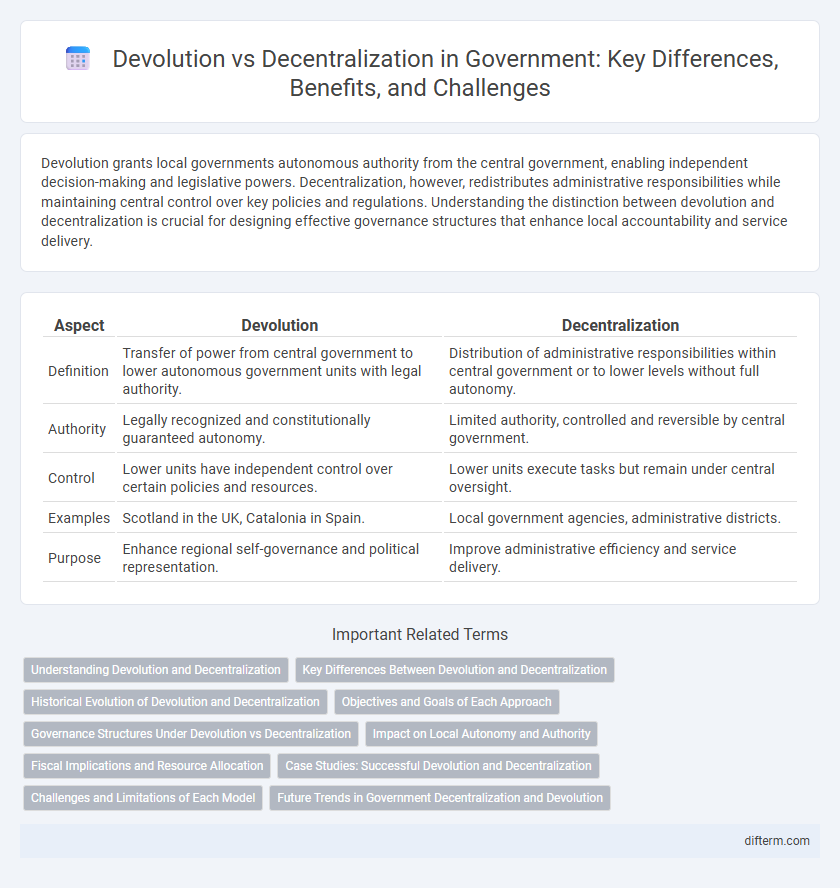Devolution grants local governments autonomous authority from the central government, enabling independent decision-making and legislative powers. Decentralization, however, redistributes administrative responsibilities while maintaining central control over key policies and regulations. Understanding the distinction between devolution and decentralization is crucial for designing effective governance structures that enhance local accountability and service delivery.
Table of Comparison
| Aspect | Devolution | Decentralization |
|---|---|---|
| Definition | Transfer of power from central government to lower autonomous government units with legal authority. | Distribution of administrative responsibilities within central government or to lower levels without full autonomy. |
| Authority | Legally recognized and constitutionally guaranteed autonomy. | Limited authority, controlled and reversible by central government. |
| Control | Lower units have independent control over certain policies and resources. | Lower units execute tasks but remain under central oversight. |
| Examples | Scotland in the UK, Catalonia in Spain. | Local government agencies, administrative districts. |
| Purpose | Enhance regional self-governance and political representation. | Improve administrative efficiency and service delivery. |
Understanding Devolution and Decentralization
Devolution involves the statutory delegation of powers from a central government to regional or local governments, granting them autonomous authority to make decisions and manage resources. Decentralization refers to the broader distribution of administrative functions and decision-making authority within various levels of government without necessarily transferring legislative powers. Both processes aim to improve governance efficiency, local accountability, and public service delivery by redistributing responsibilities closer to the citizenry.
Key Differences Between Devolution and Decentralization
Devolution involves the statutory granting of powers from the central government to lower levels of government, such as regional or local authorities, with a degree of autonomy that allows independent decision-making and legislative authority. Decentralization refers to the broader distribution of administrative functions or powers from central to local units without transferring sovereignty, often retaining ultimate control at the central level. Key differences include the legal basis of authority, with devolution requiring formal legislative delegation, whereas decentralization is often administrative and policy-driven, and the scope of autonomy granted to subordinate entities.
Historical Evolution of Devolution and Decentralization
The historical evolution of devolution and decentralization traces back to the gradual transfer of authority from central to local governments, aimed at enhancing administrative efficiency and local autonomy. Early examples include the Magna Carta in 1215, which limited royal authority and laid groundwork for representative government, and the French Revolution, which restructured local governance to reduce centralized control. Over time, constitutional reforms worldwide have codified devolution as a legal transfer of powers, whereas decentralization often occurs through administrative delegation without altering sovereignty.
Objectives and Goals of Each Approach
Devolution seeks to transfer specific powers and decision-making authority from central government to lower levels of government, aiming to enhance local autonomy, improve responsiveness to regional needs, and foster political accountability. Decentralization involves redistributing administrative responsibilities and resources within the existing hierarchical structure to increase efficiency, optimize service delivery, and promote participatory governance without necessarily granting political independence. Both approaches strive to balance power distribution and improve governance outcomes, but devolution emphasizes political empowerment while decentralization focuses on operational effectiveness.
Governance Structures Under Devolution vs Decentralization
Governance structures under devolution feature the formal transfer of authority and decision-making powers from central to local governments, creating autonomous regional entities with constitutional or statutory safeguards. In contrast, decentralization involves the delegation of administrative responsibilities to lower levels of government without ceding sovereign authority, maintaining central control over policy frameworks. Devolution promotes localized governance with legally entrenched independence, whereas decentralization enhances efficiency through redistribution of tasks within a unitary system.
Impact on Local Autonomy and Authority
Devolution grants local governments constitutional authority to make decisions independently, significantly enhancing local autonomy and political legitimacy. Decentralization redistributes administrative responsibilities from central to local agencies without transferring full authority, resulting in limited local discretion and control. The degree of impact on local authority depends on the legal framework and the extent of power transferred, with devolution typically empowering local entities more than decentralization.
Fiscal Implications and Resource Allocation
Devolution grants local governments autonomous fiscal powers, enabling tailored resource allocation that directly addresses community needs, while decentralization involves redistributing authority within the central government's framework, often limiting local fiscal discretion. Fiscal implications of devolution include increased accountability and efficiency in public spending due to localized decision-making, contrasted with decentralization's potential for fragmented resource management and dependence on central transfers. Resource allocation under devolution promotes equity by aligning funding with regional priorities, whereas decentralization may perpetuate disparities as financial control remains predominantly centralized.
Case Studies: Successful Devolution and Decentralization
The United Kingdom's devolution of powers to Scotland, Wales, and Northern Ireland demonstrates a successful case where legislative authority was transferred to regional governments, enhancing local decision-making and cultural recognition. In contrast, decentralization in Brazil's federal structure allows municipalities significant autonomy in budgeting and healthcare management, improving public service delivery at the local level. These case studies highlight how tailored transfer of power, either through devolution or decentralization, strengthens governance by aligning administrative functions with regional needs and stakeholder engagement.
Challenges and Limitations of Each Model
Devolution faces challenges such as limited fiscal autonomy and political resistance from central authorities, which can hinder the effectiveness of local governance and service delivery. Decentralization often struggles with uneven capacity across local units and risks of fragmentation, leading to inconsistent policy implementation and oversight difficulties. Both models can experience limited citizen participation and accountability, complicating governance and reducing public trust.
Future Trends in Government Decentralization and Devolution
Future trends in government decentralization and devolution indicate a growing emphasis on digital governance platforms and enhanced citizen participation through blockchain and AI technologies. Governments are increasingly shifting powers from central authorities to local entities to improve service delivery efficiency and local accountability. Data-driven decision-making and intergovernmental collaboration frameworks are becoming pivotal in optimizing decentralized governance structures for enhanced regional development.
devolution vs decentralization Infographic

 difterm.com
difterm.com